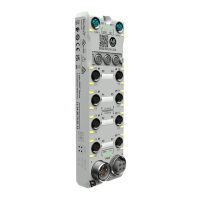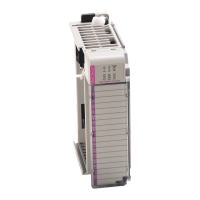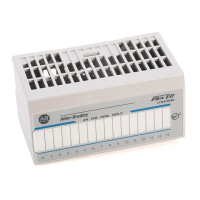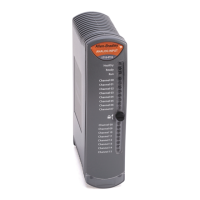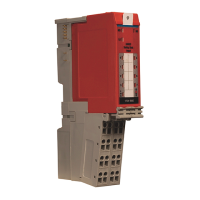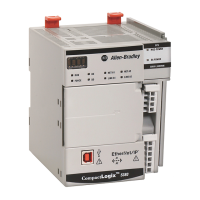24 Rockwell Automation Publication 5032-UM001A-EN-P - April 2023
Chapter 3 I/O Channel Features
Pulse Latching
You can use Pulse Latching to detect or latch short duration pulses. Pulse Latching is
supported through the Timestamping feature and Timestamp Latching.
To use Pulse Latching, you must complete the following:
• In the Module Definition dialog, configure the channel as “Digital Input, Timestamp” or
“Digital, Input, Timestamp, Fallback”.
See Module Definition
on page 45.
• In the Module Properties for the channel, select which input transitions you want to
capture time stamps for.
• Select the Enable Timestamp Latching checkbox for the channel.
See XX - Digital Input, Timestamp
on page 51.
Chatter Detection Chatter Detection is a feature that is directly related to Timestamping. You use the feature to
detect when a device that is connected to the module input causes chatter.
Chatter occurs when the device causes the inputs to transition falsely many times in a
relatively short period. As a result, the module time stamps invalid input transitions.
You can configure the following:
• Chatter Count – Determines the number of acceptable input transitions that can occur
in a given time period before considering the input to be chatter.
Valid chatter count values range from 2…127.
• Chatter Time – Determines the amount of time within which the number of input
transitions are counted.
Valid chatter time values range from 1…10000 ms.
To set the Chatter Detection options, see XX - Digital Input, Timestamp
on page 51.
Configure Channel Output
State When Module is in
Program Mode or Inhibited
You can configure individual output channels to specific states when the IO-Link master
module is in Program mode or when the module is inhibited.
When the controller switches from Run mode to Program mode, the output can behave in the
following ways, depending on how you configure the Output State in Program Mode parameter:
• Turn off - Default
• Turn on
• Hold its last state
When the IO-Link master module is inhibited, the output behavior follows the Output State in
Program Mode configuration.
To configure the output states in Program mode or when the module is inhibited, see XX -
Digital Output on page 52.

